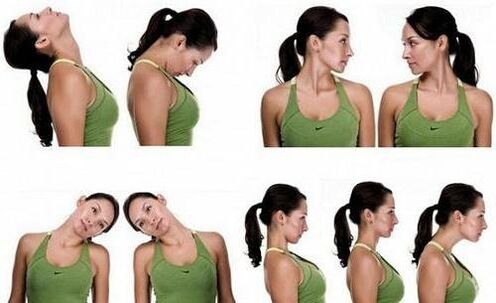Cervical spine (CS) osteochondrosis is one of the most common pathologies of the musculoskeletal system. Every year, doctors diagnose the disease more and more often, and it gets worse. According to statistics, degenerative-dystrophic changes in the upper spine are more common in women, especially in patients in the postmenopausal period. The main symptoms of cervical osteochondrosis in women are pain, limited mobility, lack of cerebral circulation, which is dangerous not only for health but also for life. You should start treatment in the early stages to protect yourself from the dangerous consequences of the pathology. It is important to carry out complex therapy and lifestyle changes to stop the destruction of spinal segments and prevent serious complications.
Development of the disease
The cervical spine is most susceptible to various injuries and degenerative changes. This is because this segment is the most mobile and the muscles are weak here. The small cervical vertebrae continue to be under severe stress every day, which leads to the gradual destruction of the intervertebral discs. The vertebrae press against each other, so the cartilage pads between them lose a lot of fluid and begin to deteriorate and deform.
In addition, osteochondrosis of the cervical spine develops due to insufficient nutrition of cartilage tissue. And the spinal canal in this area is narrow, so it is often constricted, which leads to neurological symptoms.
In the early stages, women may experience pathological heaviness in the back of the head, bloating in the hands, and so on. Patients often confuse the first signs of the disease with overwork.
There are many blood vessels and nerve roots in the neck, and when compressed, neurological diseases can occur. It is especially dangerous if a deformed disc or spinal cord compresses the spinal artery that feeds important parts of the brain. When squeezed, coordination is impaired, a woman may lose balance, vision and hearing may be impaired, and the risk of stroke increases.
Reference. According to statistics, most cervical osteochondrosis occurs in patients aged 25-40 years. The reason for this is a massive decrease in physical activity, sedentary work. Women are more likely to be diagnosed with the disease than men because they have more fragile spine and fine bone tissue.
Doctors distinguish 4 stages of osteochondrosis STORE:
- Stage 1 - the intervertebral disc loses some moisture, the height decreases, cracks may appear in the fibrous ring (outer shell). This is a stage of cervical chondrosis that is difficult to diagnose because of the unexpressed symptoms. The neck gets tired quickly, there is discomfort, heaviness in the injured area, and sometimes a slight pain that passes quickly.
- Stage 2 - cracks on the surface of the disc increase, the pulposus nucleus (like the gel in the disc) is displaced, it can come out of the damaged areas. This is what the cartilage lining, which can compress the spinal cord and roots, looks like. Periodically there may be severe pain, weakness, limited mobility, numbness in the face, neck, shoulders, arms.
- Stage 3 - the protrusion breaks the outer shell of the disc, so a hernia is formed. The pain becomes more pronounced, there are neurological diseases.
- Stage 4 - the disc is almost completely destroyed, the spine is rubbed against each other, bone growths (osteophytes) appear at the edges, prepared to stabilize the damaged part. Nerve endings, spinal cord, blood vessels are damaged. Adjacent joints begin to be damaged. Clinical signs are announced.
It is easiest to stop degenerative-dystrophic changes in the first two stages of osteochondrosis. In stage 3, complex treatment will help stop further destruction of the spinal segment. You can't do without surgery at the last stage.
Reasons
Osteochondrosis SHOP is often complex and long lasting, with several causes. In most cases, it occurs as a result of a pathological sedentary lifestyle, diet, metabolic diseases. Often, the disease occurs due to injuries or due to the natural aging of the body and the weakening of its defenses.
Doctors identify the main causes of osteochondrosis SHOP in women:
- Disorders of metabolic processes.
- Passive lifestyle.
- Genetic predisposition.
- Chronic muscle tension around the cervical segment.
- Posture curvature.
- Lack of fluid and nutrients in the body.
- Stay in a restless position for a long time (neck stretches forward and back bent).
- Excess weight.
- Frequent wearing of high heels.
- STORE INJURIES.
- Lift heavy objects.
- Autoimmune pathologies.
- Frequent stress, chronic fatigue.
- Hypothermia.
- Infectious diseases.
- The neck is too long or too short and so on.
All these factors nourish the intervertebral discs and cause their degeneration.
Female cervical osteochondrosis can be caused by genetic predisposition, intrauterine diseases, pathologies of the vertebral artery associated with trauma during childbirth. The disease can occur as a result of rheumatism, endocrine diseases, overload of the cervical segment during pregnancy, local overload.
It is important. The main cause of cervical osteochondrosis in women is menopause, as well as changes associated with this period. At this stage, the concentration of progesterone in the body, which is very important for bone tissue, decreases. The likelihood of degenerative changes is associated with age-related weakening of the neck muscles and weakening of the vertebral support in this area.
Symptoms
Osteochondrosis is characterized by a wave-like course when the acute period is replaced by remission. Exacerbation can lead to infections, injuries, hypothermia, and long-term stress on the neck.

The first signs of cervical osteochondrosis in women are headache, restlessness, heaviness in the neck. It is important to distinguish the pain of chondrosis from migraine or autonomic dysfunction in a timely manner.
In women, the clinical manifestations of osteochondrosis SHOP are caused by neurological syndromes:
- Cervical dyscalgia occurs when nerve endings are irritated by fragments of damaged cartilage. Then there is a certain crisis in the neck, pain, which is more pronounced when moving the head and after lying down.
- Scale muscle syndrome is a damage to the blood vessels and nerves of the brachial plexus and subclavian artery. This symptom complex is accompanied by pain in the affected side of the inner surface of the shoulder. The extremity is pale, cool, edematous, numb. When the patient turns his head, the neck pain extends to the back of the head.
- Shoulder-scapular periarthritis syndrome - dystrophic changes affect the tendon fibers surrounding the shoulder. Pain in the neck spreads to the shoulder and shoulder girdle. The neck has a forced position - it is bent to the affected side and the shoulder is slightly lowered.
- Vertebral artery syndrome - a blood vessel is compressed by a damaged disc or pieces of osteophyte (depending on the stage of the disease). The patient has dizziness and headache, nausea, and sometimes vomiting. The pain is localized in the occiput, crown and temples.
- Heart - spinal cord nerve bundles are damaged. There is heart pain, arrhythmia. If C3 is damaged, there is pain in the middle of the neck, the tongue is swollen, and the patient is unable to chew normally. If C4 is damaged, there is discomfort in the shoulder girdle, clavicle, and heart. With the defeat of C5, the pain response from the neck extends to the shoulder girdle, the inner surface of the shoulder. Irritation C6 manifests itself as pain from the neck and scapula to the shoulder girdle and spreads along the arm to the thumb. If C7 is damaged, the pain syndrome spreads to the back of the shoulder girdle, occupying all hands, including the index and middle fingers. When C8 is compressed, the pain spreads from the affected area to the elbow and little finger.
In addition, a woman's emotional area may be disturbed, weakness arises, worries, touches. Insomnia often occurs, and memory and attention are impaired due to regular headaches.
Symptoms of a cerebrovascular accident can occur when a woman suddenly throws her head back, bends over, or does something that puts a strain on her arms and cervical spine, such as when digging, painting the ceiling, and lifting weights.
Disorders of cerebral circulation are manifested by dizziness, trembling gait, "flies" in front of the eyes, tinnitus, weakness, nausea. In some patients, the voice becomes hoarse, sometimes disappears, and a sore throat appears.
Osteochondrosis during menopause is accompanied by migraine, increased body sweating in the area between the neck and shoulder girdle. When the vertebral artery is constricted, the cardiovascular system is disrupted.
If the disease persists for a long time, there is a lack of blood circulation to the important centers that perform neuro-endocrine functions. Atherosclerosis of the cerebral and coronary arteries develops due to increased permeability of the vascular walls.

Diagnosis
If you notice signs of osteochondrosis, consult a therapist. After a visual examination, a specialist will refer you to an orthopedist, vertebrologist or neurologist.
The following methods are used to diagnose cervical osteochondrosis:
- X-ray allows you to learn that the patient has changed the location of the spine, the presence of osteophytes at the edges, the distance between the vertebrae is reduced. For this, the work is carried out at different levels. The doctor draws pictures of the landscape to show in detail the characteristic changes.
- CT of the cervical spine provides detailed information about pathological changes in the spine. This method is used in severe diagnostic cases, allowing to obtain volumetric images for a more detailed study.
- MRI is used to accurately assess the condition of the soft tissues (nerves, blood vessels, ligaments, muscles) in the affected area.
- Electromyography allows you to check the permeability of a nerve fiber.
Doctors can also order a Doppler ultrasound (Doppler ultrasound of the large arteries of the brain) to determine the state of blood flow in this area.
Conservative treatment
Treatment of SHOP osteochondrosis in women in the early stages can be done at home. However, the doctor must develop a therapy regimen. It is important to understand that this is a long time and it is unlikely to be completely cured (especially for older women).
Complex treatment includes:
- Take medicine.
- Use of orthopedic devices.
- Physiotherapy.
- Physiotherapy procedures.
- Massage, affect by hand.
- Alternative treatment.
Conservative methods will help to stop pain, inflammation, normalize muscle tone, improve metabolic processes, nourish the damaged segments of the spine. With timely therapy, it is possible to stop the pathological changes.

Medications for cervical osteochondrosis will help relieve inflammation and pain.
Treatment of cervical osteochondrosis in women is carried out with the use of drugs that will help improve the metabolism of cartilage lining between the vertebrae, stop inflammation and pain. The following drugs are used for this purpose:
- NSAID. May help relieve mild to moderate inflammation and pain.
- Analgesics. The pain stops.
- Preparations to improve cerebral circulation.
- Muscle relaxants help relieve muscle spasms.
- Chondroprotectors. They help to stop the destruction of the disc, improve metabolic processes and speed up recovery.
- Magnesium-based drugs.
- Nootropics. They stimulate brain activity by normalizing blood circulation and have a mild sedative effect.
Reference. Therapeutic blockades with severe pain that cannot be relieved by oral medications, such as Novocaine or NSAIDs, are used.
Treatment can be supplemented with anti-inflammatory and analgesic gels, creams and ointments. They will be effective in remission or in combination with oral medications.
The decision to choose a drug combination is made by a doctor. The specialist will prepare a regimen for taking the drug and determine the dosage. It is important to follow the recommendations of many of the above drugs, as they threaten with dangerous complications.
STORE In the acute stage of osteochondrosis, a woman should refrain from strenuous physical activity. To loosen the cervical segment, you must wear a special corset (Shantz collar) that will straighten the vertebrae. This device is recommended for long-term sedentary or strenuous physical activity.
Physiotherapy procedures will help reduce pain and improve blood circulation in the affected area:
- Diadynamic therapy.
- Magnetotherapy.
- Electrophoresis.
- Electroanalgesia.
- Ultraviolet radiation, etc.
The therapeutic effect manifests itself after about the third session, then headache, hearing loss, visual disturbances, dizziness, sleep normalizes or disappears, and the general condition improves.
With the help of underwater traction of the cervical segment, it is possible to widen the distance between the vertebrae, free a nerve or blood vessel from compression, and restore the normal position of the vertebrae.
Massage will normalize muscle tone, reduce the flow of lymphatic fluid, which causes swelling. After a few sessions, blood circulation in the affected area improves.

Therapeutic gymnastics is one of the most effective ways to treat osteochondrosis of the SHOP. Sports therapy allows you to strengthen the weak muscles of the neck, which will take some of the load off the spine and help to stop or slow down the degenerative-dystrophic changes. During classes, blood circulation improves, metabolic processes, disc nutrition are accelerated, which has a positive effect on their condition.
Women should train every day. These are simple but effective exercises. The complex consists of curves using the hands, bending the head in different directions and neck movements. These elements can be performed at home, but only with the permission of a doctor. Physiotherapy exercises are performed only in remission.
Complex treatment includes reflexology (acupuncture), hirudotherapy (leech therapy), swimming, etc.
Surgery
Surgery is prescribed in the final stages of osteochondrosis of the SHOP, accompanied by severe destruction of osteochondral structures. In addition, surgery is necessary if conservative methods are ineffective or if the spinal canal is significantly narrowed.
An anterior cervical discectomy is performed in the cases described above. During the procedure, the doctor immobilizes the damaged part of the spine and removes the hernia that compresses the spinal nerve. Then the vertebrae where the disc is removed are joined. If necessary, the space between the vertebrae is filled with a synthetic attachment (cage).
After 3-5 days, the patient is released home. The rehabilitation period is about 12 weeks. To speed recovery, you need to take medication, wear a corset, lead a healthy lifestyle, go to physiotherapy procedures, and eventually take sports therapy.
Lifestyle recommendations
You need to adjust your lifestyle to quickly get rid of the unpleasant symptoms of osteochondrosis and stop the degenerative-dystrophic changes in the cervical segment. To do this, the patient must follow the following recommendations:
- Take daily walks, avoid running, jumping and other explosive activities.
- Heavy objects should not be carried.
- You can not sit for long, in extreme cases, wear a corset and periodically hold a horizontal position.
- Do special physical exercises for the back muscles at home.
- Sleep on an orthopedic mattress and a special pillow.
- Follow a diet, supplement your diet with foods rich in magnesium, calcium (nuts, dairy products, seafood, legumes), as well as plant fiber, chondroitin (mixed meat, jelly). Avoid fatty, fried, too salty foods and alcohol. The doctor will give more information about the rules of nutrition. But in any case, it must be right.
Hypothermia should not be allowed, warming will be useful in the absence of an inflammatory process.
Complications
In the absence of timely treatment of cervical osteochondrosis, a woman may experience the following pathological consequences:
- Probability of protrusion turning into a hernia after a while. Swelling causes neurological damage by squeezing the nerves as well as the spinal cord.
- Osteophytes occur when the disc is severely damaged; irritates spinal nerves and blood vessels.
- In advanced cases, there may be a strong weakening of the neck muscles or incomplete paralysis, and then the head involuntarily hangs sideways or forward.
- Compression of the vertebral arteries, impaired blood circulation in the affected area. This condition can lead to neuralgia (pain along a nerve pathway), hearing and vision impairment.
- Paralysis of the hands (incomplete or complete).
- Brainstorming.
If a woman deals with this issue in the early stages of osteochondrosis SHOP, then she will be able to prevent the above conditions.
Preventive measures
Ideally, the prevention of osteochondrosis of the SHOP should also be addressed during intrauterine development. The expectant mother should rule out factors that adversely affect the development of the fetus: infections, oxygen starvation, intoxication. If a birth injury occurs, the newborn needs treatment.
To reduce the likelihood of developing osteochondrosis SHOP, a woman should follow these recommendations:
- For example, load the spine evenly, for example, carry the load in both hands, or turn to the right and then to the left.
- Do not lift too much weight yourself.
- Try to avoid neck injuries and hypothermia.
- When working in the garden, take a break every 1. 5 hours and rest for 20 minutes.
- Choose shoes with cushioned soles that soften the strokes when pairing or jumping.
- When sitting for long periods of time, use a high chair with a headrest or a corset.
It is also important to eat properly, control weight, avoid stress, take vitamins for medical reasons, and treat pathologies that can cause osteochondrosis in a timely manner. It is recommended to visit sanatoriums to undergo treatment in remission.
The most important
As you can see, cervical spine osteochondrosis occurs more often in women than in men, because the former has a more fragile spine and fine bone tissue. The patient's pathology is especially sensitive in the postmenopausal period. The disease manifests itself with pain, neurological diseases and dangerous symptoms of cerebrovascular accident. It is recommended to start treatment at an early stage to prevent dangerous complications of osteochondrosis. To do this, a woman must take medication, adjust her lifestyle, go to physiotherapy procedures, get massage and physical therapy. Surgical treatment is indicated only in advanced cases. To prevent pathology, you should observe moderate physical activity, treat injuries and diseases that can cause osteochondrosis in a timely manner.












































